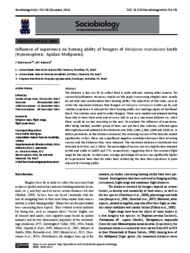Influence of experience on homing ability of foragers of Melipona mandacaia Smith (Hymenoptera: Apidae: Meliponini).
Influence of experience on homing ability of foragers of Melipona mandacaia Smith (Hymenoptera: Apidae: Meliponini).
Author(s): RODRIGUES, F.; RIBEIRO, M. de F.
Summary: The distance a bee can fly to collect food is quite relevant, among other aspects, for successful pollination. However, studies on this aspect concerning stingless bees usually do not take into consideration their homing ability. The objectives of this study were to verify the maximum distance that foragers of Melipona mandacaia Smith can fly, and whether experience is relevant for their homing ability in a Caatinga region of Northeast Brazil. Five colonies were used to collect foragers. These were marked and released starting from 100 m from their nests and at every 100 m up to a maximum distance on which there would be no bee returning to the nest. To evaluate the influence of experience, after being marked, another group of bees was put back into colonies, collected again after eight days and released in five distances only (500, 1,000, 1,500, 2,000 and 2,500 m). In both experiments, as the distance increased, the returning success of the bees decreased significantly. In fact, there was a significant negative correlation between their returning success and the distances they were released. The maximum distance a translocate bee returned to its hive was 2,700 m. The percentage of success was very high for bees released at 500 and 1,000 m (100% and 77%, respectively), suggesting this is the common flight range for the species. In most cases, average percentage of success was significantly higher for experienced bees than for other bees reinforcing the idea that experience is quite relevant for homing ability.
Publication year: 2014
Types of publication: Journal article
Unit: Embrapa Semi-arid Region
Keywords: Abelha, Abelhas sem ferrão, Autonomia de vôo, Bee, Insect, Polinização
Observation
Some of Embrapa's publications are published as ePub files. To read them, use or download one of the following free software options to your computer or mobile device. Android: Google Play Books; IOS: iBooks; Windows and Linux: Calibre.
Access other publications
Access the Agricultural Research Database (BDPA) to consult Embrapa's full library collection and records.
Visit Embrapa Bookstore to purchase books and other publications sold by Embrapa.

